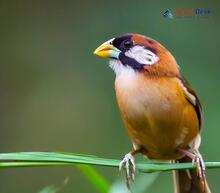Nestled among the world's highest peaks and dense forests, Nepal is a treasure trove of biodiversity. This South Asian country is home to a remarkable range of unique and captivating bird species, beckoning bird enthusiasts from all corners of the globe. One such fascinating genus that has captured the attention of bird lovers is Paradoxornis, a group of birds shrouded in mystery and intrigue.
A Profile of the Paradoxornis Genus
Paradoxornis birds, commonly known as parrotbills or paradoxornithids, belong to the family Sylviidae. These small to medium-sized birds stand out with their stout bodies, short wings, and strong bills with an upper mandible curving slightly downwards—resembling a parrot's beak. The name "Paradoxornis" itself is derived from Greek words that mean "unexpected" or "unusual," fitting for this enigmatic genus.
Habitat and Distribution
Paradoxornis birds can be found in various habitats across Asia, from scrubland and grassy plains to lush forests. In Nepal, these captivating creatures can be spotted in subtropical and temperate forests, where they often forage for food at high elevations. Their diet consists mainly of seeds and insects which they gather with their unique bills.
Behavior and Social Structure
These elusive birds are known for their secretive nature and preference for staying hidden among thick vegetation. They are generally shy creatures but occasionally showcase their vibrant personalities through their calls— a series of distinctive, melodious, and sometimes even whistling notes.
Paradoxornis species often move around in flocks, displaying a strong sense of social structure. This cooperative system features pairs working together to build nests, incubate eggs, and raise their young. Their tight-knit nature presents birdwatchers with a unique opportunity to observe the complex dynamics of these feathered communities.
Conservation and Threats
While some Paradoxornis species can be relatively common in certain regions, others face threats due to habitat loss and fragmentation. Nepal's rapid deforestation and urbanization have caused a decline in suitable habitats for these birds, putting them at risk. Conservation efforts are essential in preserving the unique biodiversity of Paradoxornis found within Nepal’s borders.
In Conclusion
The Paradoxornis genus is as captivating as it is elusive, with its unmistakable appearance and enigmatic behavior. As bird enthusiasts venture into the pristine forests of Nepal, they may just catch a glimpse of these intriguing avian wonders. Raising awareness about this exceptional genus and stressing their importance within Nepal's ecosystem will contribute towards preserving their habitat, ensuring that future generations can admire these incredible paradoxornithids for years to come.

